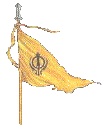
|
- Sikhism
_____________________________________________________________
_________________________________________________
From the 11th century onward North India was subject to invasions from the Afghans and Turks. Punjab which has been the gateway into India since ancient times, bore the brunt of the Islamic onslaught. The victory of the invaders meant not just a new ruler but a ruler who was committed to spread his religion among the conquered people - with all means, fair and foul.
 | The Nishan Saheb. This saffron flag Defended Our Self-Esteem and Re-asserted Our Original Humanist and Rationalist Outlook. |
Towards this end the Muslim conquerors imposed the Jazia tax on the conquered i.e. non-Muslim people, destroyed non-Muslim places of worship and converted people to Islam at the point of the sword.
On the other hand the existing religion, Hinduism with its unbending caste system and rigid ritualism had become long overdue for reform. Voices of dissent against orthodoxy and ritualism had begun to be heard even before the birth of Sikhism. Dyaneshwar and Namdeo in Maharashtra, Basaweshwara in the south were among those who preached the message of equality of all humans irrespective of their caste and creed. Such was the environment in which was born Nanak whom the Sikhs look upon as their first Guru.
The Life-Story of Guru Nanak Dev Ji
The life story of Nanak is eloquent as to the nature of the society that surrounded him as also of the mind of this simple yet noble person.
Nanak was born in the year 1469 at a village near the present-day city of Lahore. He was born in a Kshatriya family. His family is said to have belonged to the Bedi sub-caste. At his birth, we are told by the Adi Granth that 33 crores of Gods paid homage to the infant. His mother Tripta was noted for her piety and his father, Kalu was a merchant by profession.
Nanak was a brilliant boy since his early days and had mastered many of the Shastras while still young. We get an insight into the boy's mind when during his thread ceremony he riddled the officiating Brahmin priest, with questions as to how the mere placing of a thread around his body could initiate him into the religion.
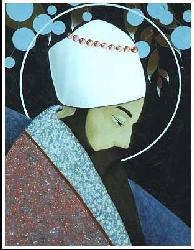 | Guru Nanak Dev Ji was a brilliant boy since his early days and had mastered many of the Shastras while still young. We get an insight into the boy's mind when during his thread ceremony he riddled the officiating priest, with questions as to how the mere placing of a thread around his body could initiate him into the religion. |
As a young man Nanak was fond of visiting ascetics and hermits and brooding over the discussion he had with them. Troubled by Nanak's non-wordly attitude his father tried to settle him in business. But Nanak's mind was involved in something far beyond the ordinary affairs of life. Once having given a large sum of money to be paid to another merchant Nanak non-chalantly distributed the sum among a group of beggars and returned home empty-handed. After this his father gave up hope of rehabilitating his errant son in wordly affairs.
The God "Brahm" appears before Nanak
Nanak continued to brood over issues dear to him. One day his brother-in-law who had come on a visit to Nanak's place decided to take Nanak with him and install him in Government service. In this assignment Nanak was fairly successful but his mind roamed elsewhere. Once when he had gone to have his morning bath, he disappeared into a nearby forest where it is said, God appeared before him and said "I am God, the primal Brahm" and you are the Guru. Three days after disappearing into the forest Nanak returned. But he did not wait long, he gave up his job, distributed among the needy whatever possessions he had and with one companion whose name was Mardana and who was a musician, Nanak set out to preach his gospel.
Nanak combined his preachings with devotional music and became a popular evangelist. Another technique of his to attract quick attention was his attire, which was a combination of the tradition of the Hindu and Muslim dress. This way he also emphasized the superfluous nature of tradition and in his preachings, emphasized that there was a religion greater than the one embodied in tradition and rituals. An important theme of his preachings was "There is no Hindu Muslim, all are the children of God".Na koi Hindu, na koi Turak, sab hai kudrat de bande
Nanak's Ridicule of Hollow Ritualism
Spreading his gospel he visited many places of pilgrimage. Once while he was on a visit to Kashi (modern Varanasi) he saw people taking a purificatory bath in the Ganges and then throwing water in a particular direction so that it reached the heavens where their departed ancestors resided. On seeing this Nanak joined the devotees, but he started throwing water in the opposite direction. When asked the reason for his anomalous behaviour, Nanak explained that he was watering his fields in Punjab which were about 500 miles from Kashi. On hearing his explanation he was made a laughing stock of the crowds but he turned the tables on his scornful audience by asking them how the water could reach the heavens if it could not reach his fields just 500 miles away.
Though born a Hindu, Nanak was quite careless of the formal demands of Hinduism and openly attacked some of its practices. Once during his travels he asked for food at a wayside house and was offered deer meat which he ate heartily. For this he was rebuked by Brahman priests. But Nanak felt no qualms for having violated convention and his caustic reply to the priest was that, it was foolish for a man who was born of flesh and who continually lived in flesh to abstain from eating it. In his sermons he frequently ridiculed rituals held sacred by the orthodoxy.
Once during a sermon he posed a question to his audience as to what was the point in going to snake pits and worshipping a snake as a God when they would kill the same snake without hesitation if it chanced to enter their homes. Nanak's views would have sounded heretical and sacrilegious to the devout, but during his lifetime itself Nanak had acquired a considerable following among the peasantry in Punjab.
 | The Ek Onkar signifies the oneness of God. This symbol is the Omkar in the Gurumukhi Script. In its graphic as well as in its concept Ek Onkar is quite similar to Om or Omkar. |
Nanak's visit to Mecca and the Kaaba
In the course of his missionary activity Nanak often visited foreign countries. According to local folklore, he is said to have visited, Mecca in the guise of a Muslim devotee. But his ignorance of Mohammedan etiquette nearly cost him his life. On his first night at Mecca he slept with his feet towards the Kaaba. He was rudely awakened by an Arab clergyman who said, "Who is this sleeping Kaafir (infidel), who lies with his feet towards God?". To this Nanak replied "Turn my feet in the right direction where God is not". And when the clergyman turned Nanak's feet to the proper Mohammedan position, the sacred Kaaba itself turned round following Nanak's feet in their semi-circular revolution - or so, we are told, through Sikh folklore.
 | The Guru Granth Saheb incorporates the hymns of Namdeo, Kabir and other saint-reformers apart from those composed by Guru Nanak Dev Ji and sung by his devotee Mardana. |
Hindu and Muslim disciples of Nanak
Nanak continued his missionary activities till the end of his days. When his end was near he had acquired a large following among the Hindus and also among some Muslims who had recently been converted to Islam at the point of the sword by the Sultans and Mughals who then were in power at Delhi. But when Nanak lay on his deathbed an unseemly quarrel broke out among his followers. The Hindus wanted to cremate the body of their Guru. while the Muslims wanted to bury it. We are told that to teach a lesson to his warring disciples Nanak asked each of the groups to place flowers at his dead body on either side and those whose flowers remained fresh throughout one night could have possession of his body. But after this was done, to everybody's surprise on the said morning when the shroud was lifted there was no body but only flowers and all of them were fresh. Thus even after his death as during his life Nanak taught the people the falsity of the barriers of religion.
Sikhism after Nanak
Nanak had appointed a disciple of his, named Angad, to succeed him as the next Guru. During Nanak's days there were many preachers who spread similar views among people. Dyaneshwara, Namdeo. Basaveshwara, Kabir, Tulsidas were a few among them. But it was only Nanak's tradition that 1ived on while that of the others withered away soon after the death of the founders. The reason why only Nanak's tradition survived the death of the founder could be found in the fact that Nanak did not present himself as belonging to any particular religion and his message was directed towards all.
Nanak wanted to propagate a message of universal brotherhood and did not limit himself with reforming the religion of his birth, although one of his objectives was to rid Hinduism, of casteism and ritualism. Another and more important reason could be the line of successive Gurus that followed Nanak and continued, to preach the message of universal brotherhood whose propagation he had initiated. After Nanak came 9
Gurus who succeeded each other in the following order:
________________________
Guru Nanak Dev Ji
Guru Angad Dev Ji
Guru Amardass Ji
Guru Ramdass Ji
Guru Arjan Dev Ji
Guru Hargobind Saheb Ji
Guru Har Rai Saheb Ji
Guru Har Kishen Saheb Ji
Guru Tegh Bahadur Saheb Ji
Guru Gobind Singh Ji
Guru Granth Saheb Ji
____________________________
Sikhism under the Successive Gurus
Nanak did not present his teachings as though they were a separate religion but laid emphasis on the universal brotherhood among all humans irrespective of the religion they followed. But gradually the followers of Guru Nanak and of the, Gurus, who succeeded him acquired the status of a distinct religion which was one among the many others which had existed till then. To begin with no name was given to the followers of Guru Nanak but later on they acquired a name. The term 'Sikh' used to describe term means 'disciple' of the Guru and is derived from the term 'Shishya' which in Sanskrit means 'disciple'.
The 22 Segments
Under every successive Guru, the position of the followers as a separate and organised religion was further crystallized. The third Guru Amardass divided the territory inhabited by his followers in twenty two segments and spiritual administrators were appointed for each of the segments. The fourth Guru Ramdass established a temple near Lahore which could be looked upon by the followers as the seat of spiritual and temporal authority of the Guru. This temple was called the Harimandir and later the Harmindar Saheb or the Darbar Saheb Gurudwara. A lake was dug around it for devotees to bathe before offering prayers. This lake was termed the Amrit-Sarovar (lake of nectar) from which the city that grew around it derived its name 'Amritsar'.
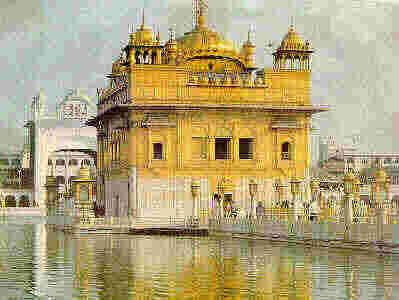 | The fourth Guru Ramdass established a temple near Lahore which could be looked upon by the followers as the seat of spiritual and temporal authority of the Guru. This temple was called the Harimandir and later the Harmindar Saheb or the Darbar Saheb Gurudwara. A lake was dug around it for devotees to bathe before offering prayers. This lake was termed the Amrit-Sarovar (lake of nectar) from which the city that grew around it derived its name 'Amritsar' |
The fifth Guru Arjan Dev compiled the Sikh canon)the Adi Granth (later to be called Guru Granth Saheb Ji) which alongwith the Sukhmani and the Japjee compi1ed by Guru Nanak, forms part of the worship (Ardas) of the Sikhs.
Guru Arjan Dev instituted practices which were to have far-reaching impact on the making of the Sikh community. In this he was surpassed only by the last Guru, Gobind Singh.
'Piri' and 'Miri'
Guru Arjan Dev declared that it was the duty of every Sikh to give one tenth of his income to the communal treasury and he appointed collectors for each of the twenty two segments to implement this. Thus Sikhism became a theocracy and a state of which the Guru was virtually a king. He used to wear two swords one on each hip which came to known as the 'Piri' the Saint and 'Miri' the Administrator. Here we see the combination of the role of the Church and the State in the context of Sikhism.
Amibivalance towards Hinduism
Though Sikhism began as a message of universal brotherhood among followers of all religions, it was gradually itself transformed into a separate religion. Its relationship with Hinduism remained a problematical one. This was so although as the Gurus preached the message of universal brotherhood all the Gurus themselves and almost all of their followers were drawn from Hinduism. Added to this was the burden of oppression of the Mughal emperors who looked upon the Sikhs as a group of heretical Hindus who tried to sow confusion amongst the followers of Islam. Guru Arjan Dev Ji tried to resolve the status of Sikhism by stating that:
"I have broken with the Hindu and the Musalmaan.
I will not worship with the Hindu, nor like the Musalmaan go to Mecca,
I shall serve Him and no other,
I will not pray to idols, nor say the prayer of the Musalmaan
I shall put my heart at the feet of the one Supreme Being,
For we are neither Hindus nor Mussalmaans.
Martydom of Guru Arjan Dev
But in the eyes of the Mughal rulers, the followers of the Gurus were Hindus who tried to undermine Mughal sovereignty. For this the Sikhs were violently repressed. In the reign of the Mughal Emperor Jehangir, Guru Arjan Dev Ji was the first Guru to be martyred (at the hand of the Mughal oppressors). Jehangir sentenced Guruji to be beheaded after being tormented for days. Burning hot sand was poured on his bare body. After being subjected to such inhuman torture, Guruji we are told, expressed a desire as his last wish, to have a bath in the Ravi river before being beheaded. Guru Arjan Dev Ji who had suffered brutally at the hands of his Mughal tormentors, went into the river till his head disappeared into the swirling currents of the Ravi - never to return. Thus he became the first Sikh Guru to lay down his life due to Mughal oppression.
It was under the later Gurus that Sikhism came to appear as the militant wing of the Hindu community. The idea of Sikhs being defenders of Hinduism was strengthened during the tenure of the 9th and 10th Gurus. Guru Tegh Bahadur and Guru Gobind Singh. During the tenure of these two Gurus the nature of the Sikh religion underwent a fundamental change. And from being a sect with ascetic and pacifist ideals, the Sikhs were transformed into an aggressive military theocracy.
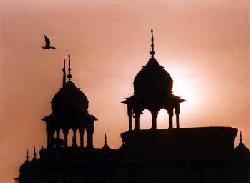 | The Mughal rulers had no love for a sect that originated from among the Kafirs (Hindus) but had adapted Islamic ideas like monotheism rejection of idol worship, military theocracy and who with the indigenous Hindu terminology of expression tried to secure a following also among the adherents of Islam. This was unbearable to the Mughals who looked upon the Sikhs as wanting to usurp the platform of Islam and stall the process of converting Hindus (in Punjab) to Islam.. |
Militarization of the Sikhs due to Mughal Oppression
The changes brought about by Guru Gobind Singh were so fundamental that they represented a new phase in the history of Sikhism. It is worth recalling the circumstances that led to this change. Understanding this phase of Sikh history is all the more important as it led to the formation of Sikhism as we know it today.
This phase of the Sikh religion was a direct result of Mughal oppression. The Mughal rulers had no love for a sect that originated from among the Kafirs (Hindus) but had adapted Islamic ideas like monotheism rejection of idol worship, military theocracy and who with the indigenous Hindu terminology of expression tried to secure a following also among the adherents of Islam. This was unbearable to the Mughals who looked upon the Sikhs as wanting to usurp the platform of Islam and stall the process of converting Hindus (in Punjab) to Islam.
Sikhism was in the eyes of the Mughals - a Panic Reaction of the Hindus against Islam
For the Mughals, Sikhism represented a panic reaction from within the Hindu community to salvage its status as non-muslim by accepting the positive ideals of Islam like rejection of idol worship, casteism and ritualism of its Hindu parent religion and infusing militancy into the new Hindu converts to Sikhism. In the eyes of the Mughal rulers, the Sikh reform was detrimental to the conversion of the Hindus to Islam; and the militancy of the Sikhs was harmful to the security of the Mughal empire. Hence the bitter oppression of the Sikhs by the Mughals which was even more severe than the oppression of the Hindus in general.
During the reign of Aurangzeb the severest wave of oppression was unleashed on Non-Muslims with a view to Islamize the country. As the Mughal oppression found tough resistance from the Sikhs they were the favourite target for the Mughals. Here the story of Guru Tegh Bahadur and Guru Gobind Singh needs to be
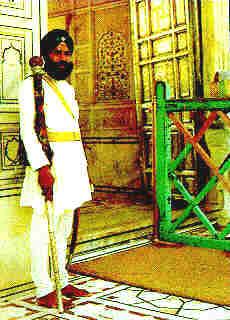 | For the Mughals, Sikhism represented a panic reaction from within the Hindu community to salvage its status as non-muslim by accepting the positive ideals of Islam like rejection of idol worship, casteism and ritualism of its Hindu parent religion and infusing militancy into the new Hindu converts to Sikhism. In the eyes of the Mughal rulers, the Sikh reform was detrimental to the conversion of the Hindus to Islam; and the militancy of the Sikhs was harmful to the security of the Mughal empire. Hence the bitter oppression of the Sikhs by the Mughals which was even more severe than the oppression of the Hindus in general. Seen here is a Keshadhari dwarpala guarding a Gurudwara. |
The Martyrdom of Guru Tegh Bahadur
During the reign of Aurangzeb Guru Tegh Bahadur who was the then Guru of the Sikhs was approached by a group of Hindu Pandits from Kashmir with a plea for protection from Mughal oppression. True to the spirit of his faith the Guru decided to approach the fanatical Mughal emperor Aurangzeb himself for a redress of the grievances. Unfortunately at the Mughal court he received abuses and threats. He was told to accept Islam on the pain of death. To prove his word the Mughal emperor Aurangzeb tourtured to death the members of the Guru's entourage one after the other. But Guru Tegh Bahadur did not lose his composure and calmly demanded a halt to the repressive policies. Wanting to teach a lesson to the obstinate Guru and to set an example to his followers the emperor ordered that the Guru to be beheaded. Thus after Guru Arjan Dev, Tegh Bahadur was the second Sikh Guru to meet a violent death at the hands of the Mughals. But after his execution some of his followers managed to sneak out the Guru's severed head from Delhi and carried it to Anandpur. At the place where the Gurus severed head was cremated, a Gurudwara was erected to commemorate this sacrifice undertaken in defence of the Dharma. This place is known to us today as the Anandpur Saheb Gurudwara.
The Khalsa Panth of Guru Gobind Singh Ji
When Guru Tegh Bahadur was martyred, his son Gobindrai, who later became Guru Gobind Singh) was still a boy, but the events which had overtaken his father, influenced him deeply and after succeeding his father as the next Guru, he was determined to carry out the struggle against Mughal oppression. Towards this end he undertook a radical transformation of the Sikh religion. This transformation was too fundamental to be termed as a reform and it virtually amounted to the establishment of a new religious order. And though he transformation differentiated the subsequent Sikhism (the Khalsa Panth from the earlier one; more in temporal and worldly aspects rather than in spiritual matters, it led to the first major split among the Sikhs.
 | The Kirpan. One of the five Kakkars. Guru Gobind Singh's aim in forming the Khalsa Panth was to build up a militarized community which could resist Mughal oppression. |
The five Ks (Kakkars)
The transformation of Sikhism as the Khalsa Panth was formally launched by Guru Gobind Singh Ji on Baishakhi (New year) day in the year 1699. The new community was termed the Khalsa Panth or the 'Pure Sect' as its followers were required to be far more strict in observing the tenets of their reformed faith. The followers of the Khalsa were required to observe five visible symbols of membership. These signs as we know were: 1) Unshorn Hair (Kesha), 2) A curved dagger (Kirpan), 3) A comb (Kangva), 4) A steel bangle (Kada), 5) A pair of shorts (Kachha). All members of the Khalsa were required to suffix their name with the term 'Singh' meaning 'lion'. Guru Gobind Singh's aim in forming the Khalsa Panth was to build up a militarized community which could resist Mughal oppression. An anecdote about his forming of the Khalsa army is worth recalling.
The Formation of the Khalsa Army
Once the Guru was delivering an inspiring speech before a group of Sikh youths on the necessity for every youth in the community to be ready to sacrifice everything he had including his life for the cause of his faith. The response of the youths was enthusiastic and many expressed their readiness to get enrolled in the Khalsa Panth. But the Guru' s standards of integrity were very high and he said that he would require the heads of those who wanted to join the Khalsa. The Guru pulled out his sword and beckoned the enthusiastic youths to come forward and lay down their lives there and then.
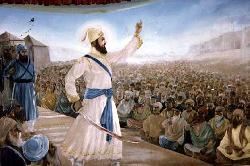 | The Guru' s standards of integrity were very high and he said that he would require the heads of those who wanted to join the Khalsa. The Guru pulled out his sword and beckoned the enthusiastic youths to come forward and lay down their lives there and then. The youths weredumbfounded and for some moments nobody volunteered to sacrifice his life, while the Guru waited with his unsheathed sword in hand. Finally one of the youths turned up and offered his head to the Guru saying that his head already belonged to the Guru and the Guru may have it if he wanted. |
The youths were dumbfounded and for some moments nobody volunteered to sacrifice his life, while the Guru waited with his unsheathed sword in hand. Finally one of the youths turned up and offered his head to the Guru saying that his head already belonged to the Guru and the Guru may have it if he wanted. The Guru caught hold of the youth and led him inside the sacrificial tent that had been erected for the occasion. After sometime there was a piercing scream form the youth and the Guru emerged from the tent and in his hand was a blood-stained sword. The Guru now demanded another head.
His audience was benumbed at this evident gruesome scene and many devotees fled the place in disgust saying that the Guru had gone mad! But out of the few remaining youths another one offered his head to the Guru. After some time a few select youths had offered their heads to their Guru and has been "sacrificed" by the Guru, while many others had fled carrying with them the memory of a ghastly episode.
But those who fled were never to learn the secret of what happened to those brave youths, five in number, who had offered their heads to the Guru and who were the first Panj Pyaras. Contrary to the impression that he created, after leading every youth into the tent, the Guru embraced each of them and installed them as his select soldiers who were to form the Khalsa army. This army was the bravest that could be had as it was made up of men who had proved that they would lay down their lives to serve their Guru and the Panth in their struggle with the Mughal oppressors.
The Fierce Commitment to Overthrow Mughal Oppression
There is also a less known tradition which Guru Ji is said to have shared orally with the Panj Pyaras in the tent after they had offered him their heads. After baptising them as the first 5 members of the the Khalsa "Pure" Panth Guru Ji decided to have the Panj Pyaras observe the 5 kakkars which included wearing a Kada (signifying a bangle) - as a sign of not yet having fulfilled a commitment of overthrowing the Mughal tormentors who then ruled Punjab(and the rest of India). The Kada was meant to instill a compelling sense of commitment in them to defeat their Mughal tormentors.
 | The Kada (Bangle). The reason for Guru Govind Singh Ji's inculsion of the Kada among the five kakkars was not mentioned in the Sikh scriptures for obvious reasons and is also not reflected in the Sikh legend. But it was this act on part of Guru Ji that spurred on his followers to avenge their oppression by the Muslims and finally led to their successes under Maharaja Ranjit Singh. |
This aspect of the kada signifying womanhood and shame was later not mentioned for obvious reasons and is not reflected in the Sikh legend. It was this act on part of Guru Ji that spurred on his followers to avenge their oppression by the Muslims and finally led to their successes under Maharaja Ranjit Singh in 1799.
(This tradition of fighting Delhi was quoted again by the terrorists during the anti-Indian insurgency of the 1980s. But then the rulers of Delhi were different in 1980 from those in 1699!)
Sahejdharis and Keshadharis
Those members of the Sikh Panth (sect) who observed the five visible signs, and also used the suffix "Singh" (lion) with their names, imbibed the fighting spirit inculcated by Guru Gobind Singh. They came to be known as Keshadharis (wearers of unshorn hair) and those Sikhs (i.e. virtually all the remaining people of Punjab) who revered the Gurus but did not accept the 5 Kakkars laid down by Guru Gobind Singh Ji and did not use the suffix "Singh" were called Sahejdharis (casual devotees), or plainly speaking - Punjabis (i.e. Punjabi Hindus).
The Sahejdharis were also followers of the Gurus, though they did not belong to the Khalsa Panth. And despite this difference, there did not exist a feeling of belonging to different sects among the two sects of the followers of the Gurus till recent times.
Banda Bairagi
Banda Bairagi personifies the ethos of Punjab. His story signifies the oneness of the Sahjedharis and the Keshadharis. Banda Bairagi was born into a Sahejdhari family. He was a devout person from his childhood. Immense love for the Guru attracted him to Guru Govind Singh Ji. In his youth, Banda Bairagi became a Keshadhari and was baptised as Banda Singh Bahadur by Guru Ji. Banda Singh Bahadur carried on a relentless fight against the Muslims. After a stormy life, full of daring adventures, he died on the battlefield fighting the Mughal Oppressors. His name has become legendary in Punjabi folklore.
 | Banda Singh Bahadur was one of the most valiant of Sikh fighters. He was born into a Sahejdhari family as Banda Bairagi, but in keeping with the tradition of those days, he subsequently became a Keshadhari. Banda Singh Bahadur was both a real Banda (follower) of the Guru and a Bahadur (fearless) warrior. He has become a hero in Punjabi legend. |
The Political History of the Sikhs
The later history of the Sikhs is more a political history rather than religious and centers around the establishment of a sovereign kingdom by Maharaja Ranjit Singh. Here let us digress into the politico-military situation in North India in the mid 18th century.
The Persian Invasion of 1740 by Nadir Shah
The immediate impetus for the establishment of the Sikh kingdom came from the invasion of North India by Ahmed Shah Durrani (Abdali) the ruler of Afghanistan in 1759/61. On his way to Delhi, Ahmed Shah burnt down the Harmindar Saheb Gurudwara at Amritsar.
 | The Third Battle of Panipat in 1761, weakened both the Afghans and the Marathas. Maharaja Ranjit Singhji stepped in to bridge this gap and he consolidated and extended Indian Rule in Punjab after a gap of 800 years. Since the year 1020, when the last Punjabi King, Tirlochan Pal Shahi had been defeated by Mahmud Ghazni, Punjab had been under Muslim rule till the Marathas under Shrimant Raghunath Rao liberated Punjab from its Muslims rulers in 1756. The Marathas marched beyond Punjab to reach Attock in Paktoonistan in 1756. But the Maratha rule in Punjab lasted only for a few years up to 1761 when Abdali again invaded Punjab and burnt down the Golden temple. But the brief intermission of Maratha rule in Punjab paved the way for re-assertion of Indian Rule in this frontier province under Maharaja Ranjeet Singh Ji. A large part of the credit for the re-establishement of Indian rule in Punjab goes to generals like Hari Singh Nallua and Jussa Singh Ahluwalia and the many valiant Sikh soldiers who extended the frontiers of Indian rule into Afghanistan right up to Kabul. |
Abdali stayed on in Delhi for 2 years and was planning to settle in India forever, when he was challenged by the Marathas. The Marathas who then were on their ascendancy in North India had since the first Persian-Afghan invasion by Nadir Shah, the king of Persia in 1740, established themselves as a dominant power in Northern India. The 20 years from 1740 to 1760 saw a see-saw battle between the Afghans and the Marathas for the domination of North India.
With the defeat of Mohammed Shah, the Moghul Emperor in 1740 by Nadir Shah (in whose army Ahmed Shah Abdali was a general), the Mughal power steadily declined and its place was usurped by the Rohillas who were led by an ambitious and ruthless chieftain named Najib Khan. Najib's ambition was to supplant the Moghal Emperor and crown himself as the ruler of India by capturing Delhi.
The Rise of the Marathas in Punjab
But the growing power of the Marathas in their northward expansion, stood between Najib and his ambition. To overcome the Marathas, in 1755, Najib invited Ahmed Shah Abdali from Afghanistan to help him in defeating the Marathas and crown himself the ruler of India. In this, he was thwarted by the Marathas who decisively defeated the Rohillas and Afghans near Delhi in 1756. The defeat was so decisive that Najib Khan surrendered to the Marathas and became their prisoner. The Maratha forces were led by Shrimant Raghunath Rao and Malhar Rao Holkar.
After defeating the Afghan-Rohilla forces, the Marathas pursued the Afghans into the Punjab upto the Khyber pass. The last frontier of the Marathas was at Attock in today's NWFP (or Paktoonistan) on the Afghan border. Thus after nearly 800 after the last Punjabi King Tirlochan Pal Shahi had been defeated by Mahmud of Ghazi in 1020 C.E. did that part of India come under Indian rule in 1756 due to the liberation of Punjab by the Marathas.
 | Guru Govind Singh Ji was like a storm for the Mughal Oppressors. He moved from place to place fighting the Mughals. Most of his life was spent on horseback. It would proper to say that it was he who kindled the spirit of independence among Indians in Punjab to fight Muslim tyranny |
Meanwhile with machinations and trickery, Najib Khan won over Malhar Rao Holkar and secured his release. On his release Najib started to undermine the Marathas once again and treacherously killed Dattaji Shinde (eldest brother of Mahadji Shinde) . Najib continued to battle the Shindes in 1757-58 and with his newly found confidence again invited Ahmed Shah Abdali to invade India.
The 3rd Battle of Panipat - 1761
Abdali's second invasion was launched in 1759. The Marathas who after their successes in 1756 had been hibernating in Maharashtra and Central India again woke up and in alliance with the Jat King Suraj Mal of Bharatpur formed an alliance. This alliance led by Shrimant Sadshiv Rao Bhau and Shrimant Vishwas Rao (the Peshwa Shrimant Balaji Baji Rao's son) won spectacular victories and captured Delhi and Kunjapura (where the Afghan treasury and armoury was located).
Here the alliance developed cracks due to the Maratha insistence on not allowing the Jats to loot Delhi. This ultimately split the alliance and Suraj Mal withdrew from the alliance.
The Marathas consequently marched upto Panipat, but instead of continuing their attacks to completely defeat the partly defeated Abdali and Najib Khan, they stayed put at Panipat, blocking the way of the Afghans back to Afghanistan. Seeing their way back to their homeland blocked, the Afghans now became restless. They in turn, decided to block the way of the Marathas back into the Deccan. This stand-off continued for a few months, while the Afghans cut-off all supplies to the huge Maratha army. The Afghans with Najib Khan meanwhile recaptured Delhi and Kunjpura.
On the decisive day of 14th January 1761, the Marathas decided to break-through the Afghan blockade and re-enter Deccan. The disastrous battle saw about one hundred thousand Maratha troops being slaughtered in a matter of eight hours. But the Afghans too suffered heavy losses and decided enough was enough and went back to Afghanistan never to return to India.
The defeat of the Marathas and the withdrawal of the Afghans created a power vacuum in North India in the period 1761-1790. It was this vacuum that was filled up by the rising Sikh power under the dynamic leadership of Maharaja Shri Ranjit Singh Ji.
The Rise of the first Sikh Kingdom
When the history of Maratha-Afghan warfare was being enacted, the Sikhs in Punjab had formed themselves into Misls (Local Armed Battalions). Though they did not actively participate in helping the Marathas against the Afghans, they nursed a grievance against the Rohillas and Afghans.
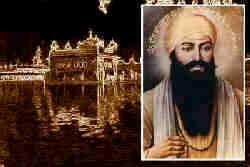 | Guru Govind Singh Ji transformed the Sikhs from being just devout and pious followers of the Guru into fierce fighters against oppression. |
On the departure of the Afghans, the Sikhs reasserted themselves in the Punjab and Maharaja Ranjit Singh Ji who was the leader of one of the most powerful Misl, formed a kingdom with its capital in today's West Punjab in Pakistan. His kingdom stretched beyond the Hindu Kush into Afghanistan. Able generals like Jussa Singh Ahluwalia, and Hari Singh Nallua helped in pushing the frontiers of the Sikh kingdom into Afghanistan.
It was a tradition in those days for the eldest son of every family from Punjab to join the army (of the Maharaja) by observing the 5 Kakkars. Brave generals like Jussa Singh Ahluwalia and Hari Singh Nallua took the Sikh armies deep into Afghanistan and they are reputed to have brought back the original Gates of the Somnath Temple which had been desecrated by Mahmud of Ghazni in the 11th century. The gates had been carried off by Mahmud to Afghanistan and had remained there ever since. Maharaja Ranjit Singh Ji retrieved them and brought them back to India.
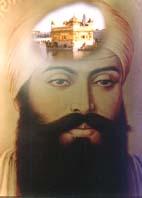 | Guru Govind Singh Ji's dream of freedom from Mughal Oppression was realised by Maharaja Ranjit Singh Ji. Maharaja Ji also repaired the Harmindar Saheb that had been burnt down by the Afghan invader Ahmed Shah Abdali, but also covered the entire temple with a sheet of gold. Maharaja Ranjit Singh Ji not only checked further Muslim invasions into India but also carried the war into the enemy's territory and captured Kabul, the capital of Abdali, thus bringing Afghanistan back under India rule after a gap of 800 years when in the year 980 C.E. Sabuktagin, the Muslim raider had occupied Kabul which had till then been ruled by Jaya Pal Shahi. Raja Jaya Pal was the last Hindu ruler of Afghanistan. |
Maharaja Ranjit Singh Ji's reign marked the consolidation of Indian sovereignty in Punjab after first Muslim invasions eight hundred years before in 1020. The Marathas had broken the continuous Muslim occupation of Punjab by liberating it in 1756 and Maharaja Ranjit Singh Ji consolidated Indian rule in Punjab a few years later.
The kingdom established by Maharaja Ranjit Singh Ji successfully resisted the Afghans, and Rohillas and also out-matched the new imperialist power of the British successfully till Maharaja Ranjit Singh Ji was alive. At his death, the Maharaja had warned about the impending coming of the British.
(On his death-bed he is said to have expressed a desire to offer his most precious possession to the Jagannath Puri temple at Orissa. He was asked by the chief Mahant (priest) of the Jagannath Puri temple as to what he considered most precious. In reply Maharaja Ranjit Singh Ji is said to have told the Mahant that as a Keshadhari follower of the Guru, his unshorn hair was most precious to him and he wanted to donate that to the temple along with umpteen gold and jewellery.)
It was during the reign of Maharaja Ranjit Singh Ji that the Harmindar Saheb Gurudwara at Amritsar which had been burnt down by Ahmed Shah Abdali in 1760, was repaired and was completely plated with gold and from then onwards it came to be known as the Golden Temple.
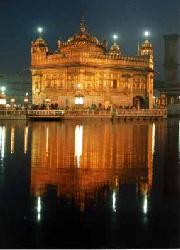 | It was during the reign of Maharaja Ranjit Singh Ji that the Harmindar Saheb Gurudwara at Amritsar which had been burnt down by Ahmed Shah Abdali in 1760, was repaired and was completely plated with gold and from then onwards it came to be known as the Golden Temple. |
Such was Maharaja Ranjit Singh Ji who consolidated Indian rule in India's frontier state which had been earlier liberated by the Marathas. Unfortunately the Marathas could not retain their hold over the liberated areas, many of which were re-occupied by the Rohillas and Afghans after a few years. But the rise of the Sikh power ensured that a large part of the Maratha achievements of rolling back alien rule could be consolidated and expanded.
The Coming of the British
The Sikh kingdom survived for some years after the passing away of Ranjit Singh but in a few years after his death the British defeated the Sikh forces at Chillianwalla in 1856 and annexed the kingdom. Maharaja Ranjit Singh Ji's son, the teenaged son Duleep Singh was taken into custody by the British and sent to London for studies! Ironically it was the Indian Sepoys (troops) of the British East India Company who fought aginst their Sikh compatriots to bring about the downfall of the last independent Indian kingdom of the pre-British period.
Though the British annexed the Sikh kingdom, they recognised the fighting spirit and bravery of the Sikh soldiers and enrolled a large number of them into the British colonial army.
The Sikh troops again ironically, proved to be loyal supporters of the British crown especially by their role in quelling the Uprising of 1857 which was spearheaded by sepoys (troops) from Bihar and the United Provinces who had mutined against the British. It was these sepoys who had earlier helped in securing Punjab for the British Crown! For this reason after 1857, troops from UP and Bihar fell out of favour with the British, and Sikh troops were favoured by them for enrollment in the army and despite participation of many Sikhs in the freedom struggle, they continued to form the bulk of Indian troops in the British colonial army and even today form a significant proportion in the Indian Army.
Modern History of the Sikhs - The Arya Samaj and the Singh Sabha
In the 19th century many parts of India - under British rule - saw a religious and philosophical revival. The Brahmo Samaj in Bengal, the Prarthana Samaj in Maharashtra, the theosophical society in Madras, the Arya Samaj in Punjab were some of these many movements.
In Punjab, the Arya Samaj was led by illustrious leaders like Swami Dayananda Saraswati and Lala Lajpat Rai. Initially the Keshadharis were also a part of the Arya Samaj. The principles of the Arya Samajis like rejection of idol worship and of casteism and reduction of ritualism made it quite familiar with the principles of the Gurus. But the rigidity of the Arya Samaj principles subjected the teachings of the Gurus critically (and in the opinion of this writer also with an evident bias against the Gurus).
In "Satyarth Prakash", the mouthpiece of the Arya Samaj, the Gurus were severely criticised and on some trumpted up argument Guru Nanak Dev Ji was called a Dambhi (Hypocrite). This unjustified criticism of the Gurus due to a negatively revivalist (reactionary) streak in the Arya Samaj alienated the Keshadharis from the Arya Samaj. As a reaction to this, most of the Keshadhari followers of the Arya Samaj split from the Samaj and joined the Guru Singh Sabha which had been formed around roughly the same time as the Arya Samaj. The Guru Singh Sabha was later to act as an ideological spearhead of the Keshadharis. This ideology was based on differentiating the Keshadharis (i.e. the Sikhs) from the Sahejdharis (i.e. Hindus). This dubious credit for creating this split between the Keshadharis and the Sahejdharis was evenly divided between the orthodoxy and revivalism of the Arya Samajis and also the teachings of some the Gurus e.g., Guru Arjan Dev Ji's statement that we are "neither Hindus nor Musalmaans". But the Sahejdhari's led by the Punjabi Brahmin orthodoxy which had a strong presence in the Arya Samaj, made a rapproachment between the Keshadharis and the Sahejdharis increasingly remote. This set the stage for the Gurudwara Agitation of the 1920s.
 | The Guru-Shishya Parampara is an ancient tradition in India and dates back to the Vedic times. |
The Gurudwara Agitation
This agitation which was launched by the Akali Dal in 1924-1925, aimed at wresting control of the Gurudwaras, from the traditional Mahants (priests) . These Mahants who held an hereditary position as priests in the Gurudwaras were mostly Sahejdhari Sikhs who had refused to conform to the five outward symbols prescribed by Guru Gobind Singh Ji. The Sahejdhari Mahants some of whom were clean shaven, were all but indistinguishable from the Hindus. Their natural affinity to Hinduism had led them to introduce elements of Hindu rituals and even image worship in the Gurudwaras and consequently Hindus (Sahejdhari Sikhs in the context of Punjab) and Sikhs (Keshadharis) worshipped together.
The Shiromani Shiromani Gurudwara Prabandhak Committee (SGPC).
These Mahants were considered to have uncertain loyalty towards their Sikh faith vis-a-vis Hinduism. And by virtue of the vital position they held as officiating priests at Gurudwaras, they represented a potent force that could merge the Sikhs with Hinduism.
After a protracted struggle the Akali Dal got the British administration to enact a Sikh Gurudwara and Shrines Act. Under this Act the hereditary tenure of the Mahants was abolished and all control Of the Gurudwaras was vested in a Shiromani Gurudwara Prabandhak Committee (SGPC).
Once having ejected the Mahants, the agitationists, threw out the images of Hindu deities, replaced the rituals and ceremonies of the Mahants by those which they considered were in accordance with Sikh scriptures and Maryada. They also appointed priests (Granthis and Jathedars) who were to be the on the payroll of the SGPC. This revivalist movement helped to strengthen the wedge between the Keshadharis and the Sahejdharis whose line of demarcation was blurred due to a common heritage.
The emphasis on Sikhs being a separate community distinct from the Hindus was sought to be expressed in terms of the 5 distinguishing symbols the Keshadhari Sikhs thus implying that the Sahejdhari Sikhs were not true Sikhs and that the religion which bore the name Sikhism was limited to members of the Khalsa Panth.
 | The Kanga which is traditionally a wooden comb is kept to keep in place the unshorn hair. The tradition of growing hair is another hoary tradition that has been followed by sanyasis, rishis, sadhus and all those who had committed themselves to take up the life of a hermit. Guru Govind Singh Ji made this older tradition a part of the five Kakkars to inculcate this spirit of commitment in the members of the Khalsa Panth. |
To a lay observer the insistence of the Keshadhari Sikhs to look upon only those members who observe the 5 visible symbols as Sikhs, and others who give up these symbols as being Patit (heretics) and having lapsed (into Hinduism) would appear gueer when the Muslims or the Christians can retain their identity as members of a religious community as distinct from the Hindus even without any external symbols.
Why is it that a Muslim without a beard remains a Muslim while a Keshadharis (Sikh) without one is looked upon as a Hindu?
The reason perhaps lies in the fact that most of the Muslims and the Christians though like the Keshadharis (Sikhs) being converts from Hinduism, own up traditions that do not originate in Hinduism or for that matter geographically in India itself. They generally look upon the history and traditions of another country as there own while those of their own country, which incidentally are bound up largely with Hinduism are for them either "infidel" or "pagan"!
This is not so among the Keshadharis (Sikhs) whose traditions have been part and parcel with those of the Hindus, in the five centuries of their existence; and for the period beyond that, the history of the Hindus and of India is their history. (The Keshadharis (Sikhs) share with the people of the rest of India, the history of the land of the Seven Rivers - a region where the concept of India first began to take shape Five Thousand years ago, which gave us the four Vedas; which gave birth to vedic seers like Vishwamitra, and Vyasa; Kings like Paurava (Porus), Ambastha (Ombhis), Shakuni, Raja Jai Pal Shahi, and Raja Tirlochan Pal Shahi; Queens like Kaikeyi, Gandhari; Scholars like Kautilya and Pannini; Universities like Takshashila, metropolises like Lav-kush Pur (Lahore), Mulasthana (Multan), Purushapura (Peshwar), Kubha-Kapisa (Kabul). The list could be endless.)
Hence the Keshadharis do not and cannot look to the history or traditions of another country or religion as their own and at the same time they do not want to be identified with the Hindus from whose ranks all of them have emerged at one time or the other, over the last 500 years.
To overcome this nagging dilemma the Sikhs (i.e. the Keshadharis), place emphasis on the most evident difference between them and the Sahejdharis (commonly termed Punjabis), which is their external symbols. The agitation for a separate Sikh state in the Punjab was in part a desperate attempt to preserve by political means the identity of a community that is precarlously perched on the verge of Hinduism and harbours a horror of going over the brink and disappearing into the quicksands of its mother faith.
Commonality of Sikhs (Keshadharis) with its Mother Faith - The Saffron Colour
This fear on part of the Keshadharis is natural as in the eyes of an average Sikh) the parallels between his faith and that of his Hindu ancestors appear close enough to be confused with each other if sought to be distinguished. The list of parallels could be an endless one. Even a superficial look at Sikhism brings out the common points. A look atop a Gurudwara cannot miss the triangular saffron flag due to which a the place of worship could be considered to be a Hindu temple unless one is aware of the distinguishing architectural features of a Gurudwara.
Sikh spiritual leaders and priests use Saffron cloth for their turbans and dress as they consider the Saffron colour to have a religious significance though in the 1980s it had become a symbol of revivalism and bigotry (for the terrorists).
 | One prominent symbol that meets the eye while looking at Gurudwara is the letter "Ek Onkar" (shown on the left) which is inscribed on Gurudwaras (it means "One God"). The concept of God as Om or Omkar is evidently borrowed from the Hindu concept of Omkar (as shown on the right) which is also inscribed on many Hindu temples. |  |
"Ek Onkar" of the Keshadharis and "Omkar" of the Hindus
The second thing that meets the eye while looking at Gurudwara is the letter "Ek Onkar" which is inscrlbed on most Gurudwaras (it means "One God"). The concept of God as Om is evidently borrowed from the Hindu concept which is also inscribed on many Hindu temples.
"Pheres" as a Wedding Custom among the Keshadharis
In spite of their horror of being called Hindus; till the 1920s, the fire (agni) and the hearth (agnikund) continued to hold a central place in their marriage rituals and a Keshadhari couple was deemed to have been married only after the couple went around the fire four times in the same manner as the Hindus do seven times in a ritual called the Saptapadi (Seven Steps) or Phere. But in the last few decades, the fire has been replaced by the Adi Granth and the rounds have been reduced from seven to four. Although the custom of Pheres has remained. Like the Hindus the Keshadharis cremate their dead. Ritual bathing before performing religious ceremonies in Gurudwaras is still a current practice which is parallel to the Hindu practice of bathing in rivers or tanks considered holy, before entering a temple.
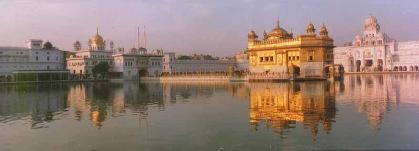 | The pond or lotus pond (Pushkara) that is built near many Hindu temples has its parallel to the Amrit-sarovar around the Golden temple at Amritsar. |
The pond or lotus pond (Pushkara) that is built near many Hindu temples has its parallel to the Amrit-sarovar around the Golden temple at Amritsar.
Even the practice of growing a beard and hair and tying it up in a knot atop one's head is not peculiar to the Keshadhairs. Since ancient times those who entered Sanyasa, the last stage of an ideal life for a Hindu, grew beard and hair and tied the hair in a knot atop their heads. The presence of long hair and beard was a sign of a man who had forsaken material pursuits. Those who accepted Sanyasa right since their celibate boyhood (Brahmacharya) had to wear unshorn hair and tie it atop their heads. Such persons were known as Keshin i.e. those with hair. All ancient Hindu Rishis (seers) are shown as having unshorn hair. Even today Sadhus and Sanyasis have unshorn hair. A Sikh without a turban appears quite similar to a Hindu Sadhu. It is quite possible that the inspiration for wearing unshorn hair come from the hoary tradition among the Hindus.
The Guru-Shishya Parampara
The Guru-Shishya tradition which is the core of the Keshadharis is a continuation of the same tradition among the Hindus. The Guru in traditional Hindu society is more than a coach or a tutor. He is looked upon as a spiritual guide next only to God. The Guru-Shishya tradition was natured in Ashramas and Gurukulas where education was imparted since ancient times. Children were sent to Gurukulas at a tender age and for years together they stayed with their Guru who trained them in all arts and sciences. The Guru was normally from the Brahmin caste (at times he could be a Kshatriya) hence in the eyes of his disciples (Shishyas) he could acquire a venerable and semi-divine status.
Even today this tradition of revering Gurus is not absent among Hindus as is evident from the innumerable Swamis, Gurus and Babas who are looked upon as equivalent of Gods and are an object of worship. Buddha and Mahavir (and the other Tirthankaras) also represented the same tradition as did Guru Nanak. Although many tenets of Sikhism are fundamentally different from the (generally recognised) ritualism of the Hindus, the Guru-Shishya tradition around which the Sikh Panth is built evidently betrays its Hindu Origin.
Idol Worship Among the keshadharis
Though the Sikhs reject idol worship, they look upon the Granth Saheb as their Guru. The Granth Saheb is placed on a throne (takht) where offerings are made to it and as an act of reverence, fans are waved before it so as to keep it comfortable by circulating the wind around in a way similar to that done for Kings in the past. This betrays a kind of respect for the Guru Granth as though it were a living Guru. This personifies the Guru Granth. The Granth being looked upon as an 'object' of reverence rather than only as a text that gives a message of universal brotherhood in itself betrays a trait of object worship which is but one step behind idol worship (moorti puja of the Hindus).
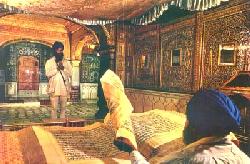 | Although the Sikhs do not worship idols their reverence for the Granth and the Golden temple betrays a very similar sentiment. The Granth Saheb is placed on a throne (takht) where offerings are made to it and as an act of reverence, fans are waved before it so as to keep it comfortable by circulating the wind around in a way similar to that done for Kings in the past. This betrays a kind of respect for the Guru Granth as though it were a living Guru. This personifies the Guru Granth. The Granth being looked upon as an 'object' of reverence rather than only as a text that gives a message of universal brotherhood in itself betrays a trait of object worship which is but one step behind idol worship (moorti puja of the Hindus). |
And although the Sikhs worship no idols their reverence for the Granth and the Golden temple betrays a very similar sentiment. One instance is the practice and the structure of the Parikrama that involves going around the Golden Temple in a circle. The concept of Parikrama is an obvious derivation from the Hindu practice of Pradakshna.
The suffix Sinqh which is today a common Sikh title has an origin older than may appear. In ancient times Hindu Kings and princes used to adopt the suffix 'Simha' meaning lion as e.g. in Narasimha Deva the ruler of Orissa who resisted the Muslims and built the Konark Temple. In mediaeval ages the Rajputs corrupted the word Simha to Sinh and Singh e.g. Gaj Singh, Uday Singh, etc. This title continued to be a trademark of the martial nobility. To inclulcate in the Sikhs, this martial tradition, Guru Gobind Singh Ji made it obligatory for Keshadharis to use this suffix after their first name. Even today the suffix 'Singh' is used by many Hindus of the Rajput and Jat castes and in some cases it has even become a surname.
Despite their insistence on having a cultural identity distinct from the Hindus the Keshadharis continue to celebrate Hindu festivals like Diwali, Holi (Hola Mohalla) and Baisikhi in a popular way. Even other traditional Hindu festivals like Janmastami, Ramnavami, Mahashivratri and Vijaya-Dashmi are observed, though keshadhari participation in these festivals is not as popular) and in recent times it seems to be on the wane.
Concepts of Karma in Sikhism
Though not known and understood popularly, the Sikh concepts about Karma and Salvation are drawn from their counterparts in Hinduism. At this stage one might wonder, why is it that so many vestiges should have survived in Sikhism when the intention of Guru Nanak Dev Ji was not to identify his disciples with any one religions, or even to establish a separate religion but to preach the universal brotherhood of man and the unity of God by whatever name he may be called?
One reason is that despite these aims of the founder, at the practical level Sikhism functioned as a reform movement among the Hindus. Almost all its converts came from the Hindus and so did All the Gurus. Due to historic compulsion like Mughal oppression, Sikhism over a major period of its history remained a spiritual, temporal and political movement of the Hindus, by the Hindus and virtually for the Hindus.
 | Although many tenets of Sikhism are fundamentally different from the (generally recognised) ritualism of the Hindus, the Guru-Shishya tradition around which the Sikh Panth is built evidently betrays its Hindu Origin. Even today the tradition of revering Gurus is not absent among Indians as is evident from the innumerable Swamis, Gurus and Babas who are looked upon as equivalent of Gods and are an object of worship. Buddha and Mahavir (and the other Tirthankaras) also represented the same tradition as did Guru Nanak. |
That Keshadhari Sikhism has still not been able to completely circumcise itself of its Hindu heritage is evident from the repeated pronouncements in shrill tones that the Sikhs are not Hindus. This dread of a loss of identity on part of the Sikhs arises from the genetic similarity between -the mother religion and the offspring. The ambivalence of the Sikhs vis-a-vis Hinduism had till recently (in the 1980s) found expression in the form of terrorist violence. And in doing so the terrorists were waging a matricidal war on a people whose religion and religion, history and culture was their own cradle. It is not surprising that several Indians regarded the activities of the terrorists as those of prodigals gone berserk. Though Keshadharis have always tried to ensure their status as an independent religious community, the anti-Hindu slant was of recent origin. Hindus (Sahejadharis in the context of Punjab) and Keshadharis had till recently never looked upon each other as members of different faiths leave alone of rival or enemy faiths.
Common Struggles of the Recent Past
Needless to recall that in defense of their faith and of themselves; they had to throw their lot with each other in the face of a common danger throughout the five hundred years of the history of Sikhism - the last occasion being in 1947.
The anti-Hindu slant of the 1980s among the Keshadharis (or at least among some sections of them) was a recent phenomenon. In its earlier days Sikhism functioned as a reform movement among the Hindus of Punjab from whom came the followers of the Gurus some of whom became Keshadharis.
Although the message of the Gurus was aimed at all humanity, it was given a sympathetic hearing mainly by the Hindus in Punjab. Its converts came almost entirely from Hinduism as did all its Gurus. Though in many respects The principles of Guru Nanak Dev Ji were fundamentally different from the various Hindu sects his message was nevertheless couched in a Hindu terminology and methods of expression. Despite the differences between Hinduism and the views of the Gurus, they could not have openly preached against the tenets of Hinduism before an audience that was made up of Hindus. Also it is doubtful if the Gurus had disowned the caste system completely, as many Sikh converts originally came from the upper castes Jats and Khatris - the caste to which Guru Nanak Dev Ji belonged.
The Possible Face of Sikhism without Guru Gobind Singh Ji's Reform
Had the last Guru Gobind Singh not recast Sikhism as the Khalsa Panth, then, it would have today been among the many sects within Hinduism like those of the followers of Sai Baba in Maharashtra, Basaveshwara in Karnataka, or the Brahmo Samaj in Bengal.
The Sahejdhari Sikhs (i.e. most Punjabi Hindus) who do not conform to the tenets laid down by Guru Gobind Singh Ji could be considered symptomatic as to how all Sikhs would have been without the tenets of Guru Gobind Singh. Among the Sikhs today there are many sects like the Nirankaris, Namdharis, Nirmalas, Sanyasis, Udasis, Radhasoamis, etc. Many of these sects come quite close to Hinduism and for this reason are frowned upon by the Akalis.
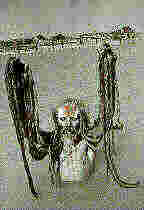 | Like the Sikhs, the Hindu Sadhus and Sanyasis have unshorn hair. A Sikh without a turban appears quite similar to a Hindu Sadhu.. |
The Dharam Yuddh Morcha of the Akalis
The Akalis, who represent the main sect among the Keshadharis had begun the Gurudwara Agitation in 1920s as also the Dharam Yuddh Morcha in the 1980s both of which increasingly acquired an anti-Hindu slant. We all know how the Dharam Yuddh Morcha of Sant Longowal had many just demands like the proclaimation of Chandigarh as a capital of Punjab and not a shared capital with Haryana. This was justified as Chandigarh was made as a capital for East Punjab after independence and partition when Lahore the former capital went to West (Pakistani) Punjab. Other demands like the sharing of river waters were more of administrative issues. The broadcasting of Gurbani on AIR (All India Radio) was an understandable demand in the light of secularism being mis-interpreted in India as religious tolerance. Apart from these issues the demand that the Anandpur Sahib Resolution be accepted so that "Sikhs could enjoy the glow of freedom" was a first step to secessionism and needed to be rejected outright as was done. The colonial administration that could have further divided the country is no more around.
(The aim of dividing up any nation further - be it India, Pakistan or any other, is a retrograde one in the 20th century. The objective should be to move towards a single WORLD STATE.)
The Demand for Khalistan
The Akali agitation gradually slipped out of the hands of the Akali leaders and degenerated into the terrorist frenzy of indiscriminate killings of all clean-shaven bus passengers, mowing down of innocent bystanders in market places, targeted assassinations of editors of newspapers (starting with that of Lala Jagat Narain), blowing up of railway tracks and trains all of which was shameful and culminated in an equally shameful slaughter of the the Keshadharis in New Delhi in November 1982 after the assassinations of the then Indian Prime Minister Indira Gandhi.
The politics of the Congress Party of propping up Bhindranwale to embrass the Akali Dal, which at that time was a part of the Janata Party ruling Delhi, was ultimately responsible for the terrorism of the 1980s. The Congress Party exploited the pre-existing feeling among some of the Keshadharis that they are a separate community and ultimately would have to have a separate nation for themselves. This was the ultimate reason for the creation of disturbances in Punjab. The aim of the Congress was to destabilize the then ruling party and ultimately seize power. The politics of the Congress party paid off, but at a tremendous cost to the nation, and to Punjab in particular.
Terrorism and its Aftermath
The Akali agitation launched between 1980 and 1985 spawned a lunatic fringe of paranoid-killers among the Keshadharis whose activities brought death and destruction to many and sowed seeds of distrust between the Keshadharis and their fellow countrymen. The aim of this lunatic fringe of terrorists was to impose a second partition on the nation and establish a theocratic-military state which they termed 'Khalistan'. The arguments put forth in favour of another vivisection Of the motherland included the Keshadharis being a separate nationality which before the coming of the British the Keshadharis had their own state under Maharaja Ranjit Singh Ji and that the Sikhs made maximum sacrifices during the freedom struggle but are now denied their pound of flesh. Yes, the Keshadharis made innumerable sacrifices during the freedom struggle (and the Partition) starting with the Gaddar movement. There were Kesahdharis like Bhagat Singh - but then there were Rajguru and Sukhdev also with him. Just as the Keshadharis had a kingdom, before the coming of the British, the Marathas also had their empire and so had many others. With this logic every linguistic group should have its own nation. And extending this logic to its foolish end, every individual should be an independent nation.
But then the such ways of thinking on part of the terrorists, contributed to vitiate the environment and create notions among the Keshadharis and Sahejdharis (in the context of Punjab and Hindus in the rest of the country) being different communities. Those in the lunatic fringe of terrorism also nutured exaggerated notions about the valour and bravery of the Keshadharis which although true was not something that could be monopolised by people in any one part of the country (or for that matter in any one part of the world). But these notions fuelled a false pride among the lunatic fringe and among those Keshadharis who decided to fall for their propoganda. The terrorists argued in such a way as if they were the only one's with a martial tradition and that others like the Rajputs, Jats, Marathas and Gurkhas, existed only in the imagination of historians.
 | Sikhism was originally born as a movement to unify humanity and overcome the fragmentation which different religions had brought about. |
Going Forward
The agony of Operation Bluestar and all those events that came before and after it in the tragic 1980s are too vivid to be recollected here. The last word on the terrorist insurgency can never be made.
The only thing one cannot refrain from saying is that the terrorists can never succeed against the will of the people of Punjab in carving up a separate state. The only thing the terrorists achieved in the 10 years of insurgency was a bad name for the Sikh community. Because of the crimes of the terrorists, in this short span of time, the Sikhs who, in the eyes of their countrymen, were respected as fearless and just warriors, fell to the status of cold-blooded killers of defenseless innocents and traitors to humanity.
However, it goes to the credit of the majority of the Keshadharis of Punjab who brought an end to the madness of terrorism by joining the Punjab Police in actively flushing out the terrorists hiding in the fields and the grasslands of the Mand.
The people brought out their tractors and guns against the Khadkoos (terrorists) and brought the misguided elements on the path of sanity. All those among the terrorists' ranks were also not fired by "service to the Panth", but had no guilt while not only asking for shelter and food from the lay Keshadhari farmers but also had the temerity of asking for sexual satisfaction from the daughters and sisters of their reluctant Keshadhari hosts. This was the last straw that turned the lay Keshadhari rural folks against the Khadkoos and everything that the Khadkoos stood for.
But it is pointless to criticize the terrorists in an emotional manner for it is doubtful as to how many of them understand the teachings of Guru Nanak Dev Ji and the other Gurus. We saw how Sikhism was originally born as a movement to unify humanity and overcome the fragmentation which different religions had brought about. But in the course of time, the noble humanist traditions of the original Sikh faith have itself acquired the status of a separate religion. This phenomenon has become acute especially in the last few decades. This process has been fuelled by Akali exclusivism which culminated in terrorist violence of the 1980s.
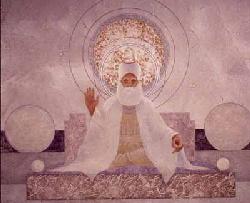 | In the course of time, the noble humanist traditions of the original Sikh faith have itself acquired the status of a separate religion. This phenomenon has become acute especially in the last few decades. This process has been fuelled by Akali exclusivism which culminated in terrorist violence of the 1980s. |
The events associated with the Sikh community in the late 19th and the 20th century, especially of the 1980s are such that they out did in terms of fanaticism and bigotry even the earlier religions which the original teachings of the Gurus had sought to unify! Even today many Keshadharis look upon themselves a separate community and they want to preserve by political means an identity which they think would be lost due to its affinity with their original faith - Hinduism.
Summary and on to the Next Chapter
With this we come to the close of the summary of religions that originated and flowered mainly in India. But as we all know these are not the only religions that exist in India. Religions like Christianity, Islam, Judaism and Zoroastrianism which originated outside India also find adherents here. The followers of Judaism and Zoroastrianism came to India as refugees and the, religions remained (confined to the descendants of the original immigrants.) Though both these religions allowed no converts from other religions; they have not remained untouched by the customs and beliefs of those of other religions.
The followers of both Christianity and Islam are overwhelmingly converts from Hinduism and for this reason still display visible tendencies of affinity with their original faith - or mode(s) of worship. To understand the fusion of customs and beliefs of different religions that came into India from other parts of the globe we shall review the history of these religions. We shall begin with Islam.
_____________________________________________________________
________________________________ _____________________________________________________________________________________
|
|
_ _ _ |
View My Guestbook
|
